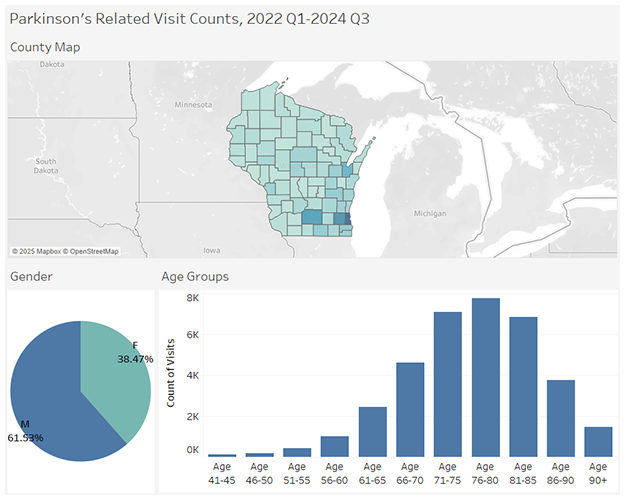Click here to view past issues
IN THIS ISSUE
- Wisconsin’s Health Care Workforce Faces Ongoing Strain as Demand for Care Remains High
- Advocacy Day Registration at Capacity, Join the Wait List Now!
- 2025 WHA Workforce Forum – May 14 in Stevens Point
- Fast Facts from the WHA Information Center: April is Parkinson’s Awareness Month
- Grassroots Spotlight: Bergmann Testifies at JFC Hearing in Kaukauna
EDUCATION EVENTS
Jan. 14, 2026
Caring for Wisconsin’s Caregivers Well-Being First Champion Challenge for Credentialing KickoffJan. 28, 2026
2026 WHA Health Care Leadership AcademyFeb. 10, 2026
Age-Friendly Webinar Series Featuring Advocate HealthClick here to view education event calendar
View more issues of The Valued Voice
Sign Up for WHA's Newsletter
Fast Facts from the WHA Information Center: April is Parkinson’s Awareness Month
April is known as Parkinson’s Awareness Month as an opportunity to increase education about the brain disorder. The National Institutes of Health states that Parkinson’s disease is a brain disorder that impacts one’s coordination, balance, shaking and stiffness. Parkinson’s Foundation writes, “Nearly one million people in the U.S. are living with Parkinson's disease. This number is expected to rise to 1.2 million by 2030.” The number of people in the U.S. diagnosed with PD each year is roughly 90,000. Parkinson’s disease is the second most common neurologic condition found in the United States after Alzheimer’s. Parkinson’s Foundation also states that worldwide, it is estimated that more than 10 million people are living with Parkinson’s.
The WHA Information Center analyzed hospital claims from January 2022 to September 2024. Men have a higher visit count than women do-similar to what national trends see of men being affected by Parkinson’s Disease more than women. The average age of a patient visiting for Parkinson’s disease is 76 years old. The age group with the highest visit count seen is ages 76-80 years old.

Below are some risk factors of Parkinson’s Disease written by the National Institute of Neurological Disorders and Stroke:
- Age—The average age of onset is about 70 years, and the incidence rises significantly with older age. However, a small percent of people with Parkinson's disease have “early-onset” disease that begins before the age of 50.
- Biological sex— Parkinson's disease affects more men than women.
- Heredity—People with one or more close relatives who have Parkinson's disease have an increased risk of developing the disease themselves. An estimated 15 to 25 percent of people with Parkinson's disease have a known relative with the disease. Some cases of the disease can be traced to specific genetic mutations.
- Exposure to pesticides—Studies show an increased risk of Parkinson's disease in people who live in rural areas with increased pesticide use.
Fast Facts from the WHA Information Center: April is Parkinson’s Awareness Month
April is known as Parkinson’s Awareness Month as an opportunity to increase education about the brain disorder. The National Institutes of Health states that Parkinson’s disease is a brain disorder that impacts one’s coordination, balance, shaking and stiffness. Parkinson’s Foundation writes, “Nearly one million people in the U.S. are living with Parkinson's disease. This number is expected to rise to 1.2 million by 2030.” The number of people in the U.S. diagnosed with PD each year is roughly 90,000. Parkinson’s disease is the second most common neurologic condition found in the United States after Alzheimer’s. Parkinson’s Foundation also states that worldwide, it is estimated that more than 10 million people are living with Parkinson’s.
The WHA Information Center analyzed hospital claims from January 2022 to September 2024. Men have a higher visit count than women do-similar to what national trends see of men being affected by Parkinson’s Disease more than women. The average age of a patient visiting for Parkinson’s disease is 76 years old. The age group with the highest visit count seen is ages 76-80 years old.

Below are some risk factors of Parkinson’s Disease written by the National Institute of Neurological Disorders and Stroke:
- Age—The average age of onset is about 70 years, and the incidence rises significantly with older age. However, a small percent of people with Parkinson's disease have “early-onset” disease that begins before the age of 50.
- Biological sex— Parkinson's disease affects more men than women.
- Heredity—People with one or more close relatives who have Parkinson's disease have an increased risk of developing the disease themselves. An estimated 15 to 25 percent of people with Parkinson's disease have a known relative with the disease. Some cases of the disease can be traced to specific genetic mutations.
- Exposure to pesticides—Studies show an increased risk of Parkinson's disease in people who live in rural areas with increased pesticide use.
IN THIS ISSUE
- Wisconsin’s Health Care Workforce Faces Ongoing Strain as Demand for Care Remains High
- Advocacy Day Registration at Capacity, Join the Wait List Now!
- 2025 WHA Workforce Forum – May 14 in Stevens Point
- Fast Facts from the WHA Information Center: April is Parkinson’s Awareness Month
- Grassroots Spotlight: Bergmann Testifies at JFC Hearing in Kaukauna

